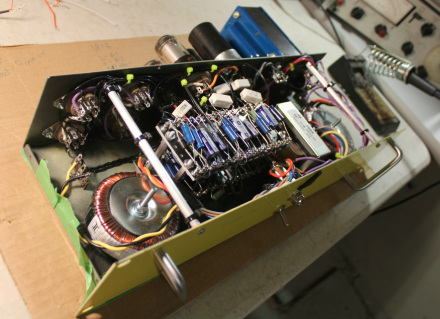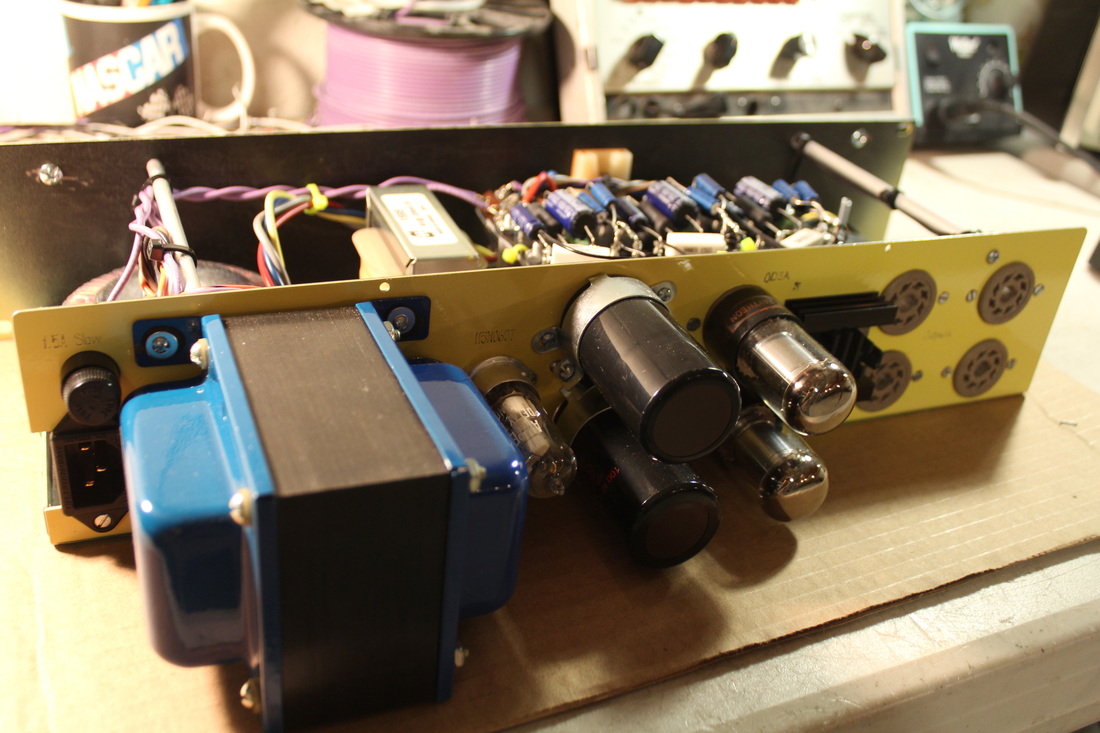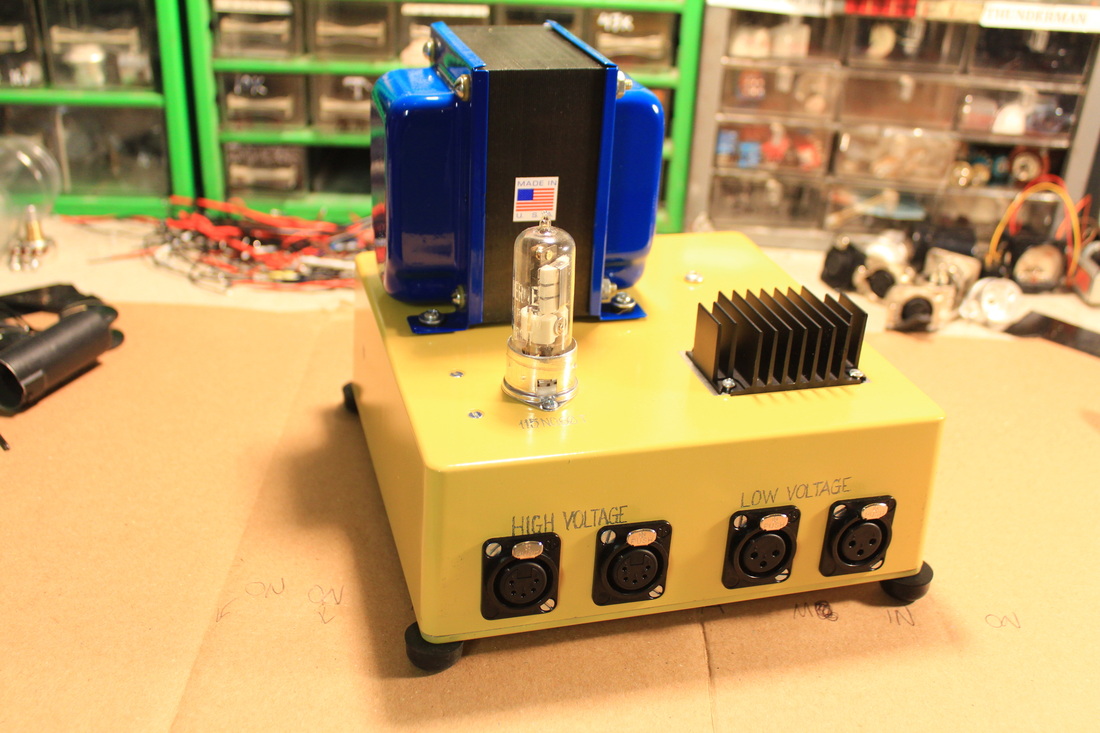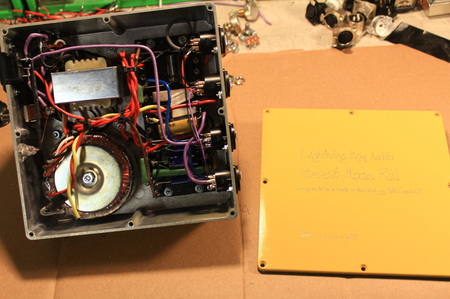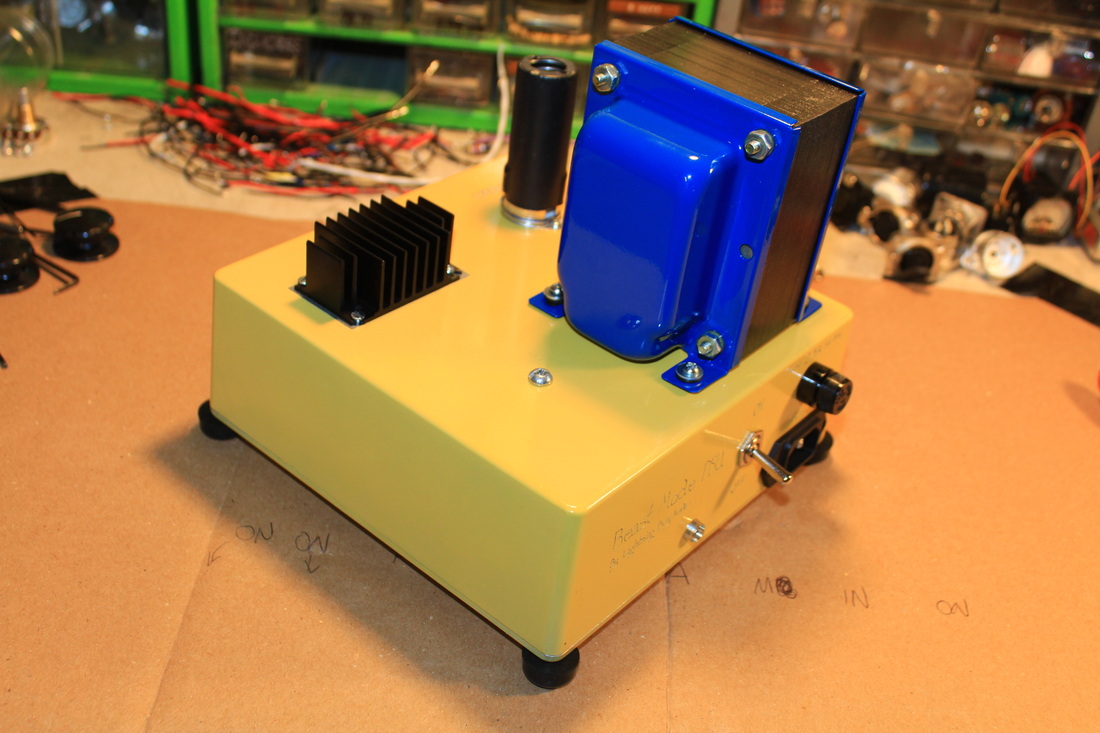Beast Mode IIJust wrapping up with the first Beast Mode II Power Supply Unit. No expense has been spared in creating this. It is the biggest, most badass power supply I have ever created. It has been said that bigger is not necessarily better. However, in this particular situation bigger is absolutely better. The Beast Mode II has been designed to supply ultra low noise, high current power to four Trinity channel strips. It has separate power transformers for the B+ power, phantom power, and tube filament supplies. The big blue transformer supplies the B+ and also has a 6v tapoff, which powers the LED circuitry. Inside is a massive power filter choke, a pair of low noise toroidal transformers, and the electronics necessary for regulation of each power supply within the Beast Mode II. On the back side can be seen the can caps, a thermal relay tube, a pair of voltage regulator tubes, the heatsink associated with the tube filament regulator supply, and the octal power sockets used to connect power to each channel of Trinity. Its definitely a strange hybrid, but it performs unbelievably well. Silicon diodes were used for all power rectification (B+, filament supply, phantom power, LED power supply). A very expensive military-grade solid-state voltage regulator is used to perfectly regulate the DC voltage for the vacuum tube heater filaments in order to achieve supremely low noise. The square black heatsink can be seen on the back side of the Beast Mode II. The two large vacuum tubes on the back are actually not vacuum tubes. They are filled with Xenon gas and are used to regulate the B+ voltage - in conjunction with capacitors & a filter choke. The resulting B+ power is perfectly free from ripple or voltage swing. The small tube on the back is actually a thermal relay vacuum tube. It controls an automated start up sequence that's much like a standby switch on a guitar amp. This standby switch automatically flips on 60 seconds after the power switch is turned on. The phantom power section offers a dedicated power supply for each channel, with each one being regulated to provide up to 2 amps of direct current at exactly 46.6 volts. The LED power section is the only non-regulated supply in the Beast Mode II. It provides 4 amps (way overkill) of direct current at 6 volts to power the LED lights on each connected channel of Trinity.
Outputs (via rear panel octal sockets):
My work of Art is not ready for the public yet. It needs to be 100% problem free, perfect in every way, and rock solid for life. Its pretty much that already, but its now a matter of fine tuning. I decided to go with some Texas Instruments regulators for the DC filament supply. These puppies are over $50 each for American-made quality vs. the $5 chinese knockoffs I used during prototyping. I figure the American stuff will probably last longer even though their technical specifications are the same. I also decided to change the power supply tether design to something safer, more robust, and unfortunately more expensive. I'm leaving the 5-pin XLR connector design and moving on to the bigger, more powerful 8-pin octal tube socket connectors... similar to the connections you would find on a vintage Wurlitzer electric piano or maybe some hammond organ stuff. Big cables with big connectors. The connectors and cabling are 3x's the price, but Trinity is destined for greatness and no parts skimping can be a part of that. I decided to go with a bigger, more power PSU which will be able to power 4 channels of Trinity. From extensive testing I have determined Trinity needs to be a mono unit, not stereo. This will ensure perfect isolation from cross talk between multiple channels.
As you can see, a lot has been going on in the further development of the product. Its going to be a major player for LBA, so there is no point in rushing to meet a deadline on this one. Its done when its done. The 1401 Stereo Mic Preamp has dropped in price from $2499.99 to $1799.99. For more information visit the 1401 Stereo Mic Preamp page here.
The release date for Trinity has been pushed back to Black Friday. This will facilitate the time required for a proper release. Meanwhile, I have begun the extensive testing of Trinity. A couple new features have been added to the design, such as a Turbo Boost switch, which adds 10dB of clean gain and a switch that toggles between Ultra-Linear mode or Semi-Linear mode. Read all about that and more on the Trinity page here. That is all. Have a marvelous day and thanks for reading! I started the build process with the most important element first. The power supply. The power supply is responsible for far more than just mere power. Its generally the largest source of noise, a major source of headroom, and a significant factor in the origins of punchiness. Therefore, in order to make a great power supply, great care and skill has to go into its design. Ladies, Gentlemen, and Rough Folk, I'm proud to share with you the first production model of The Beast Mode Power Supply Unit. Please forgive my novice photography at the bench (unofficial photos). The Beat Mode PSU is the power supply for Trinity (October 2015) and can power up to two Trinity units. It will also very likely continue on to use for future products. This is a hybrid sort of power supply since it has both solid state and vacuum tube technology onboard. The vacuum tube seen in the above photo is actually a thermal relay tube, which controls a time-delayed soft-start for the tubes on any Trinity connected. You can think of this as an automatic standby switch. Also seen in the photo is large heat sink. This is for cooling the linear voltage regulator below it. That regulator is related to the heater filament power for Trinity's vacuum tubes. It keeps it at a very stable DC voltage for superior low noise performance. The massive blue power transformer is one of 3 onboard. The other two transformers are internally mounted. This thing is really over the top in such a good way. All point to point wired. Thick high quality wiring for maximum current delivery. Big wattage resistors for low thermal noise. Low ESR, long-life electrolytic caps. Separate power transformers for each section of power: B+, Filaments, Phantom Power. The Beast Mode PSU is a heavy weight contender (it weighs a lot), but it is not the entire power supply for Trinity. Onboard each Trinity is the voltage regulation circuitry for the B+ section of the power supply associated with that particular Trinity Unit, so that each connected Trinity will have its own separate B+ supply. The regulators onboard Trinity are not solid state, they are inert gas VR tubes. In fact, nothing onboard Trinity is solid state. That definitely means the audio path is 100% pure vacuum tube heaven. And, ultra-low noise, of course.
Now that I have a working prototype the next step is building a production model. I have actually been working on this for about 4 days now. I don't like to think about this stage like prototyping, but it kind of is in a way. First step was plotting out the layout of the front and back panel components. The front panel controls needed to make sense in their layout, but also had to make sense with respect to the internal wiring. Shorter wires are always a plus, but not always the answer. The back panel layout has all the sensitive electronics; tubes, transformers, in/out connections. By sensitive I specifically mean in regards to susceptibility to electromagnetic interference and the transmission of such fields between channels. The back panel components had to be laid out in such a way as to minimize the effects of EMI to the greatest degree. After getting everything plotted I machined out the first production chassis and power supply. This stage of the game is where looks really matter. I wanted to go with a color scheme that reflected the Lightning Boy logo. Unfortunately, I was unable to find Lightning Boy yellow in my normal brand of paint. I did, however, find it in a different brand. Big freaking mistake. I painted the power supply and etched it. Looks great - no problems. Clear coated it and baked it. Done. Moving on... I painted the chassis, but when I started to etch it the paint began to flake away. WTF? Okay, maybe I messed up something when I painted it. Stripped it and tried again. Continued etching. Paint flaked off again and looks terrible. Its that damn paint! The chassis is not even salvageable. The paint was not adhering to the steel chassis, but strangely it adhered to the aluminum power supply. Ok, chalk this up as a loss and a learning experience. Back to machine work. I machined out a second chassis, but this time I found Lightning Boy yellow in the brand of paint I normally use! Yes! Had to do some serious hunting, but I have a source now. Got her painted and its currently drying. I'll etch it on Monday. I'm expecting it to work out really well. This paint brand has never failed me. More to come...
I'm working out the details of a demo video for Trinity. It looks like AEA microphones will be sending me an R88 stereo ribbon mic for use in the video, which is super cool. It makes the most sense to me to record an entire song using only Trinity preamps. It will probably be a while before I can have enough channels to do a proper full on recording with only Trinity preamps, but I'll have 4 channels at the time of the demo. 4 Channels is pretty limiting, but I can certainly pull off a decent drum recording with just 4 microphones. I've assembled a team of session players and now I just need to secure a singer/songwriter with a tasty tune. Bryan Wray, who does all the photography and videos for LBA has some awesome new gear, so I'm sure his work will be tremendous. The goal is to try to shoot this video sometime in late September with an October release of the video and product.
I have one lofty life goal that will take an insane amount of time and an extreme amount of money to fully complete, but its achievable because all of my minor goals help to achieve the greater goal. What is that great and lofty life goal? To hand-build and hand-wire, point to point... a 32 channel vacuum tube powered recording/mixing console with passive equalizers (the Arque Equalizer that is in the development stage) on every channel. It seems pretty wild, maybe even a bit insane considering I'm estimating its final value to be in the $200,000 price bracket. However, I'm very passionate about what I do and I never give up on a reachable goal until I cross the finish line.
I'm currently a good way into the design of this monster board. Trinity is a major element, which is kind of an understatement. Trinity is the channel strip for a smaller "first" console, but I will most likely use the preamp section of Trinity in the 32 channel giant, since I feel this preamp is among the best in the world. My goals right now are to build as many Trinity channel strips as possible, but really I would like to build 8. Each one is a dual channel strip, so 8 units would give me 16 channels. I'll then design and build a master summing section for the 16 channel mixer. The goal specifically is to build a 16 channel recording/mixing console based around the Trinity channel strip within two years of today. That's a pretty insane goal from a financial standpoint, but I will reach it no matter the sacrifice. I have a 3 step phase to get me to the point of having 8 Trinity's. The first phase is to sell any used gear or prototypes that I feel I can live without. I started by adding a few new listings on ebay. You can see what I have up there so far at http://www.ebay.com/usr/lightningboyaudio. Its not a lot, but I have a few more things still to get up there. Phase 2 is to sell my prototypes on a page that I have yet to create on this website. This will probably happen before next week. Finally, Phase 3 is to launch Trinity as a product so I can start ordering parts in bulk... eventually amassing enough to build a few extra for myself. I have found that one of my greatest tools for achieving goals is writing them down in a place where I will see them often. A constant self reminder is what I need to get things done in a timely manner. I decided to try posting my goals on this blog for the public to see, as a self experiment. I think if the public knows my goals and my time table, the pressure is on to complete these things accordingly. I like working under pressure. That's when my best work happens. Trinity has been an example of that and soon enough the world will hear my masterpiece. My last blog post was something about the completion of the Trinity prototype. That was the first prototype, which was the most difficult part of the development stage. The next prototype I just completed which is a full on stereo version - v1 was mono to keep the development as simplified as possible. I finished v2 a couple days ago and that was no easy task, let me tell you. You'd think it would be easy to turn 1 channel into two, but I encountered power supply issues with things overheating and not enough heater current for 6 tubes, but that has been worked out. I also encountered cross-talk issues, which have also been worked out. Both issues were not easy to fix, but we're good now. Next is implementation of phantom power into the design. After that's 100% cool I'll move onto phase 3, the first production prototype. When the production prototype is complete Bryan Wray and I will be shooting a demo video of it before I ship the unit off to its permanent home at http://bambooroomstudio.com/.
On another note, I've been thinking about adding a new page to this website in which prototypes and used LBA gear will be offered for sale from time to time. The sale of such things will directly fund the development of new products. I'll put the completed Trinity on there, as well as a mono passive tube EQ prototype, which led to the development of the Flux Bender. There's also a used 5 watt guitar amp I made, which was the precursor to the Gravitone 30 and another passive eq prototype. Not sure how much to sell the prototypes for. Some like the "Teq1" passive EQ prototype I have a personal attachment to. That particular EQ is something I use fairly often at LBA Studios and it was the second piece of functional recording equipment I ever built (first was a passive summing box). Its really unique since it has in it not only my hand made capacitors, but also a multi-tapped inductor I wound by hand. Although I do have a personal attachment to this EQ, I would consider selling it for the right price. If it sells for a good price I won't feel terrible about letting it go and the money will help LBA move forward with new designs. Its true, I'm still not done with the prototype. Its really taken much longer than I had expected. I don't want to rush this though. Trinity is really kicking ass and its super close to done. Its actually inspired me quite a bit to do some cool stuff - like build a vintage-style tube console. I have learned much along this journey and it really excites me for the future. Joe, from Bamboo Room Studio's is the first supporter and investor of this project, so I would like to thank him again for his patience and support.
Upon testing today, the preamp exhibited 70dB of gain with the Baxandall passive EQ engaged (a big source of volume loss). That's a milestone, but yesterday the preamp was oscillating when I turned up the volume too much. Fixed that as well. Just needed more shielded wire inside. Also, the noise is practically non-existent. The tone is pretty good and probably even awesome by most standards, but I would like it to be a little less colorful and a bit more perfect. Unfortunately, that will come at a price. Todays tests were conducted with no negative feedback in the signal path. By employing some negative feedback I'll be able to get the preamp sounding less colorful and more pristine, but at the cost of gain. Its completely variable and can be adjusted to taste, but I fear that it will dip into the 60dB range or lower once I have it sounding the way I really want it to sound. I'm trying my hardest to avoid having 3 tubes per channel - it currently has two. That extra tube per channel would require a much more expensive power supply, the extra pair of tubes, and additional resistors, caps, wire, labor, etc. I really don't want to see this thing escalate into ultra expensive land. In the end I will do whatever is necessary to get it sounding exactly the way I want... and I am damn picky. Tomorrow I will dial in some negative feedback to taste and hope the overall gain of the preamp stays at or above 60dB. Fingers crossed.
|
Details
About the AuthorMike Congilosi II, Owner/Designer/Electronics Engineer at Lightning Boy Audio and Owner/Audio Engineer/Music Producer at LBA Studios. Archives
April 2025
Categories |

 RSS Feed
RSS Feed
